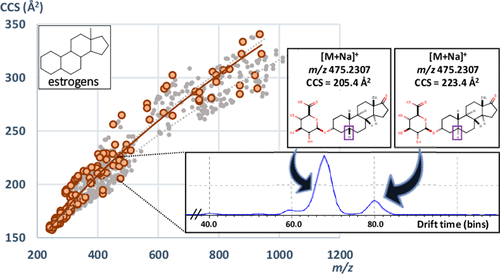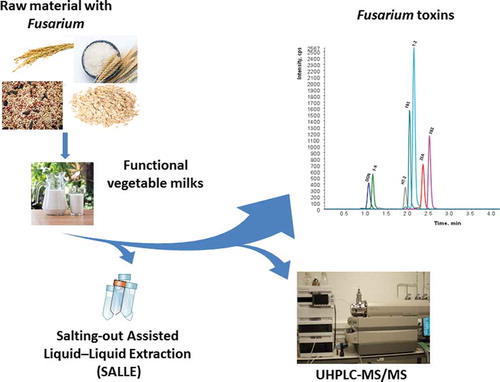Ion mobility spectrometry enhances the performance characteristics of liquid chromatography–mass spectrometry workflows intended to steroid profiling by providing a new separation dimension and a novel characterization parameter, the so-called collision cross section (CCS). This work proposes the first CCS database for 300 steroids (i.e., endogenous, including phase I and phase II metabolites, and exogenous synthetic compounds), which involves 1080 ions and covers the CCS of 127 androgens, 84 estrogens, 50 corticosteroids, and 39 progestagens. This large database provides information related to all the ionized species identified for each steroid in positive electrospray ionization mode as well as for estrogens in negative ionization mode. CCS values have been measured using nitrogen as drift gas in the ion mobility cell. Generally, direct correlation exists between mass-to-charge ratio (m/z) and CCS because both are related parameters. However, several steroids mainly steroid glucuronides and steroid esters have been characterized as more compact or elongated molecules than expected. In such cases, CCS results in additional relevant information to retention time and mass spectral data for the identification of steroids. Moreover, several isomeric steroid pairs (e.g., 5β-androstane-3,17-dione and 5α-androstane-3,17-dione) have been separated based on their CCS differences. These results indicate that adding the CCS to databases in analytical workflows increases selectivity, thus improving the confidence in steroids analysis. Consequences in terms of identification and quantification are discussed. Quality criteria and a construction of an interlaboratory reproducibility approach are also reported for the obtained CCS values. The CCS database described here is made publicly available.
Categories
- Amino acids (2)
- Animal feed (6)
- PTSO (3)
- Anthelmintic (6)
- Benzimidazoles (6)
- Antibiotics (31)
- 5-nitroimidazoles (10)
- Aminoglycosides (2)
- Quinolones (8)
- Sulfonamides (2)
- Tetracyclines (6)
- β-lactams (5)
- Cephalosporins (3)
- Biological fluids (13)
- Human serum (2)
- Pig serum (3)
- Urine (8)
- Biomonitoring (1)
- C4D (1)
- Chemiluminescence (6)
- Photoinduced (2)
- Chromatography (60)
- Capillary HPLC (12)
- GC (1)
- HILIC (5)
- HPLC (5)
- UHPLC (34)
- Contaminants (4)
- Cyclodextrins (1)
- DART (1)
- Drugs (8)
- Anaesthetics (1)
- Muscle relaxants (1)
- Steroids (1)
- Electrochromatography (1)
- Electrophoresis (40)
- Exposomics (2)
- Fingerprints (1)
- Flow injection analysis (1)
- Fluorescence (15)
- LIF (7)
- Photo-induced (3)
- Food (64)
- Aquaculture products (4)
- Barley (4)
- Cheese (1)
- Eggs (5)
- Fruit (2)
- Dried fruit (1)
- Honey (3)
- Infant foods (2)
- Juice (3)
- Maize (3)
- Meat (4)
- Chicken muscle (1)
- Pig kidney (1)
- Pork muscle (1)
- Milk (12)
- Nuts (2)
- Oat (2)
- Pseudocereals (1)
- Rice (6)
- Seeds (2)
- Spelt (1)
- Supplements (4)
- Blue-green algae (1)
- Pollen (1)
- Propolis (1)
- Royal jelly (1)
- Vegetable milks (2)
- Vegetables (5)
- Aromatic herbs (1)
- Celery (1)
- Lettuce (1)
- Milk thistle (1)
- Spinach (1)
- Wheat (7)
- Durum wheat (1)
- Wine (4)
- Yogurt (2)
- Human biomonitoring (1)
- Insects (1)
- Honeybees (1)
- Ionic liquids (1)
- Mass spectrometry (52)
- Ion mobility (4)
- Metabolites (1)
- Destruxins (1)
- Metabolomics (4)
- Pesticides (21)
- Carbamates (9)
- Fipronil (3)
- Neonicotinoids (4)
- Polar (1)
- Sulfonylurea (3)
- Pharmaceutical formulations (1)
- Plants (1)
- Potato plant (1)
- Projects (63)
- AGL2015-70708-R (21)
- B-AGR-202-UGR20 (4)
- EQC2018-004453-P (2)
- P12-AGR-1647 (26)
- PID2020–120020RA-I00 (4)
- PID2021-127804OB-I00 (5)
- PROYEXCEL_00195 (7)
- RED2018-102522-T (2)
- RED2022-134079-T (1)
- RTI2018-097043-B-I00 (9)
- Review (11)
- Sample treatment (87)
- DLLME (16)
- Dilute and shoot (2)
- Hollow-fiber liquid-phase microextraction (1)
- Liquid-liquid extraction (1)
- MIPs (8)
- NADES (1)
- Protein precipitation (1)
- QuEChERS (23)
- QuPPe (1)
- SALLE (16)
- SPE (16)
- Solid-liquid extraction (4)
- UASEME (1)
- automated SPE (1)
- on-line SPE (1)
- Sequential injection analysis (1)
- Soil (1)
- Theses (5)
- Toxins (31)
- Cyanotoxins (5)
- Mycotoxins (26)
- Aflatoxins (4)
- Enniatins (2)
- Ergot alkaloids (4)
- Trabajo fin máster (2)
- UV-vis (29)
- Water (22)
- Thermal spring (1)
- Wastewater (1)
Archives
- February 2025
- January 2025
- December 2024
- October 2024
- July 2024
- April 2024
- January 2024
- December 2023
- October 2023
- September 2023
- August 2023
- July 2023
- February 2023
- September 2022
- April 2022
- November 2021
- September 2021
- July 2021
- June 2021
- April 2021
- December 2020
- October 2020
- August 2020
- April 2020
- March 2020
- February 2020
- December 2019
- July 2019
- June 2019
- February 2019
- November 2018
- October 2018
- September 2018
- June 2018
- May 2018
- March 2018
- February 2018
- November 2017
- October 2017
- August 2017
- July 2017
- June 2017
- May 2017
- April 2017
- March 2017
- February 2017
- January 2017
- December 2016
- November 2016
- September 2016
- August 2016
- July 2016
- May 2016
- March 2016
- February 2016
- December 2015
- November 2015
- August 2015
- October 2013
- September 2013
- August 2013
- July 2013
- May 2013
- February 2013
- January 2013
- December 2012
- November 2012
- August 2012
- July 2012
- June 2012
- February 2012
- December 2011
- November 2011
- September 2011
- July 2011
- April 2011
- September 2010
- July 2010
- June 2010
- May 2010
- April 2010
- February 2010
- January 2010
-
Recent Posts
- Toxic cyanopeptides monitoring in thermal spring water by capillary electrophoresis tandem mass spectrometry.
- Liquid chromatography-tandem mass spectrometry for the determination of multiple mycotoxins in serum through suspect screening and targeted approaches: Advancing human mycotoxin biomonitoring.
- Emerging mycotoxin occurrence in chicken feed and eggs from Algeria.
- HILIC-MS and CE-MS as complementary analytical approaches to assess the impact of exposure to polychlorinated biphenyls on the polar serum metabolome of pigs.
- Analytical challenges and opportunities in the study of endocrine disrupting chemicals within an exposomics framework.
Tags





